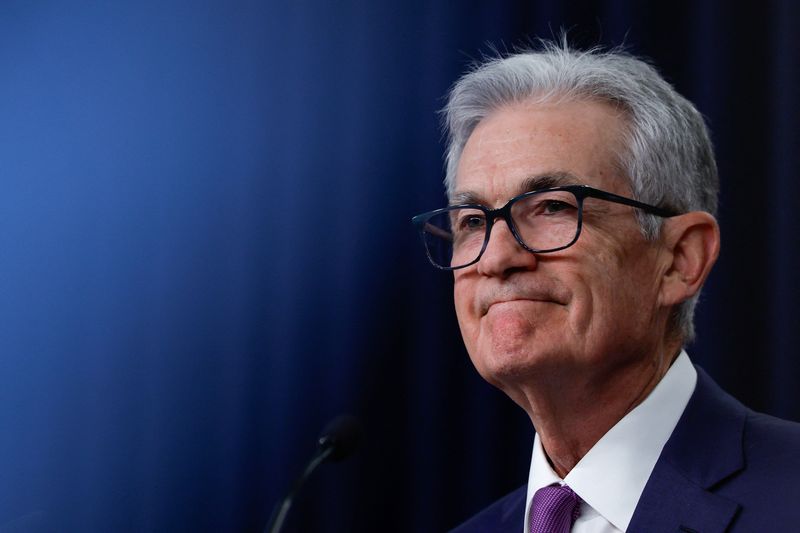By Mike Dolan
LONDON (Reuters) - The Federal Reserve may finally have interest rate markets back in the palm of its hand - but it's surely casting a wary eye on effervescent stocks that seem oblivious to its caution.
Fed chair Jerome Powell heads into two days of congressional testimonies this week confident the Fed's December message on modest interest rate cuts later this year has at last been heeded by chastened rate futures and Treasuries.
But even half a glance at the AI-seeded surge in Wall St stock indexes to new records, and a near-frenzy in chipmakers and pretty much any stock linked with the artificial intelligence boom, will have him casting his mind back to the musings of predecessor Alan Greenspan.
Greenspan sparked brief market consternation in December 1996 when, in an otherwise long-winded speech on Fed history and its mandates, he opined on "irrational exuberance" in stock markets and what the central bank should do about it.
His relatively uncontroversial answer was that bubble-like stock prices were not the Fed's concern - unless their mispricing infected the wider economy or the threat of them bursting risked destabilising financial stability at large.
But the now famous phrase hit home, upending what then seemed like frothy global stock prices for several days - on a basic assumption the Fed, which had held policy steady all that year, might be minded to prick the equity bubble with a hike.
"We as central bankers need not be concerned if a collapsing financial asset bubble does not threaten to impair the real economy, its production, jobs and price stability," Greenspan said at the time, pointing to the lack of wider impact from the 1987 market crash.
"But we should not underestimate or become complacent about the complexity of the interactions of asset markets and the economy," he added. "Thus, evaluating shifts in balance sheets generally, and in asset prices particularly, must be an integral part of the development of monetary policy."
If only he'd stayed true to that final line, many argue, we may well have avoided the even greater banking and mortgage-backed debt bubble he presided over during the following decade - a bubble which burst with devastating global consequences shortly after the Fed chief left office.
Perhaps the lesson for Powell is that Greenspan acknowledged the potential risks and did little to offset them - executing a modest rate rise in March 1997, but leaving policy on hold again for another 18 months and then cutting yet again in 1998.
In fact, even though the speech was considered a shot across the bows at the time, stocks only lost about 4% in the 10 days that followed and climbed back to record highs within six weeks.
And, as ING's Chris Turner pointed out this week, the S&P500 doubled over the following three years after that speech - only peaking at the height of the dotcom bubble in 2000. The eventual bust brought a three year bear market and the index took some seven years to reclaim new highs.
EXUBERANCE REPRISED
Yet Greenspan's take on market "exuberance" has been reprised by many financial analysts again in recent weeks to describe a similar set of circumstances facing Powell and team.
Just like during the 1991-1996 period, the S&P500 has doubled in about five years - and almost trebled in 10 years.
Although not referring explicitly to stocks, Atlanta Fed boss Raphael Bostic spoke last month of "pent-up exuberance" in the wider economy that could drive inflation back higher and how that underlined his caution about cutting rates.
While post-pandemic Fed rate rises and higher long-term borrowing costs have reined in the economy to some degree - and the bond market has tightened up a bit again since the start of this year - financial conditions more generally are loosening once again thanks to the resurgent stock market boom.
Goldman Sachs' index on U.S. financial conditions has eased back to its lowest since August 2022 this month, for example, with some 94 basis points of the 151 bps of the loosening since November accounted for by surging equities.
With U.S. households now holding the highest share of equity in their savings portfolios since the 1980s, the wealth effect for well off households may well be considerable.
Bank of England policymaker Catherine Mann, for example, pointed out last week that central bankers are struggling to get services inflation under control in part because wealthier households were relatively immune to higher interest rates and still splurging on travel, restaurants and entertainment.
And so, bubble risk aside, there may be a cogent policy reason to worry about the effects of spiralling stocks.
But it depends on the way you look at it.
Many argue central banks should cheer the AI investment boom as it spurs the sort of productivity leap that would allow economies to expand faster without overheating and obviate the need for higher rates to slow it down.
And Kristina Hooper, Chief Global Market Strategist at Invesco, reckons what looks like bubbly valuations for the stock market overall was simply down to the narrow lead of the 'Magnificent Seven' megacaps - which have expected earnings growth over the year ahead almost five times that of the 493 remaining S&P500 firms.
Unlike the late-1990s internet stocks that rose on hope, she said, these are real fundamental underpinnings.
"This isn't 'irrational exuberance' — it's more like 'rational exuberance'", Hooper wrote.

While it's unlikely Powell would want to explicitly echo his now-tarnished Fed forefather, he may well be minded to calm things down a bit - in his own inimitable way.
The opinions expressed here are those of the author, a columnist for Reuters.